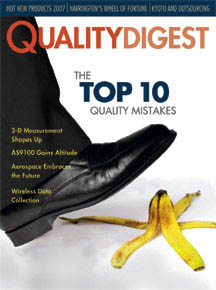 Top 10 List Top 10 List
Awesome article (“The 10 Biggest Quality Mistakes,” Craig Cochran, February 2007). We quality managers
just had our annual meeting and, as a team, we’re struggling with how to sell the value of the QMS if the general managers only view it as a case of “check in the box”—in other words, meeting the ISO 9001 requirements. It’s our jobs as quality managers to communicate the value as well as the common pitfalls that are holding us back. This article helps me sell the value. Thanks.
—Lesa Meyer
While I love this article for its objective critique on how most quality management systems are set up, I am disappointed to note that Mr. Cochran did not expand on mistake No. 6: “Applying document control only to official documents.” The scope of the article would have been complete if there was a point or two on how businesses could implement adequate controls on unofficial documents while addressing the need to disseminate the content in those documents quickly.
—Tan Ghim Meng
What a great reminder for us to keep focused on what really matters to the company, which isn’t the creation of more programs, forms, and procedures to make us look efficient and organized. It’s so easy for a program manager to get caught up in what they think is the big picture. However, this can cause that manager to make bad decisions. Far too many times, we forget the cornerstone of any effective quality program: Keep it simple.
—Norval Driskill
Where was this article two years ago when we started down the ISO 9001 path? Unfortunately, we learned pretty much everything that the author describes the hard way! I think that it was due to the fact that we worked on implementation with an inexperienced consultant. That should be the No. 1 mistake that organizations avoid!
—Mike Felten
Kyoto, the Chinese and Ford
Regarding the article “Kyoto and Quality” (“Last Word,” William A. Levinson, February 2007): While the Kyoto protocol sounds like a “job killer,” the same thought applies to wanton encouragement of all things Chinese. The U.S. government aided and abetted communist China as a bulwark against Soviet expansionism and decided to look the other way with regard to its flagrant violation of the business laws and practices that are in place throughout the civilized world. It will take a long time for the United States to match the $1.50-per-hour wages that are paid to Chinese workers.
—Parmeshwar Coomar
We need to find a way to reduce greenhouse gases, and we need to do it now. The author does make the point that we need to consider economic growth in this effort and he is right—improved lean techniques and innovation yielding improved performance with lower emissions is a win-win solution to this problem.
By the way, Ford (yesterday or today) is a poor example of an environmental shepherd. The only thing green about Ford is some of its paint jobs.
—Scott Bradley
Shifty Sigma?
Regarding the article “Sick Sigma, Part 2” (Anthony D. Burns, Ph.D., http://qualitydigest.com/sixsigma/index.lasso), when I went through Black Belt training I was skeptical about the 1.5 sigma shift as well. We learned to use Cp and Cpk to determine how well a process was doing instead of relying on Six Sigma tricks. We were taught by an old GE quality tech engineer, so this may have had something to do with it.
—Jay Clyde
Mr. Burns’ analysis is an example of why the quality community lost its seat at the business table. It’s analogous to the number of angels one can find dancing on the head of a pin. In other words, it’s generally pointless.
Six Sigma is not about statistics. The statistics are a vehicle for understanding the source of variation. Six Sigma is a consistent, common logic trail for investigating a company’s biggest business problems, reinforced and enabled by statistical tools when they’re appropriate. Taken any other way, it is a “program of the month,” which tends to die away in a very short time. Seen as a way to change a company’s culture to one focused on continuous improvement, waste elimination and variation reduction, Six Sigma works.
—George Strodtbeck
The author is right on some points, wrong on others. But where he is grossly wrong is in his understanding of Six Sigma in the first place. His article is about the Six Sigma of 10 to 15 years ago. He demonstrates no understanding of what Six Sigma actually means to companies today; how it has evolved to address some of the shortcomings he notes; or the fact that there are some companies that use Six Sigma well, and some that don’t. Putting them all into one category is a useless exercise.
|